Dals/lentils are an integral source of proteins and other nutrients for us Indians, especially vegetarians and vegans. India is also the nation that produces the largest quantity of these food crops. Paruppu as it is known in South India, has uses in various dishes ranging from salty and savory to sweets like Paruppu Payasam. This is a Pasi Paruppu Payasam or Moong Dal Payasam – a creamy, decadent pudding of yellow moong lentils, jaggery, coconut milk and flavored with cardamom.
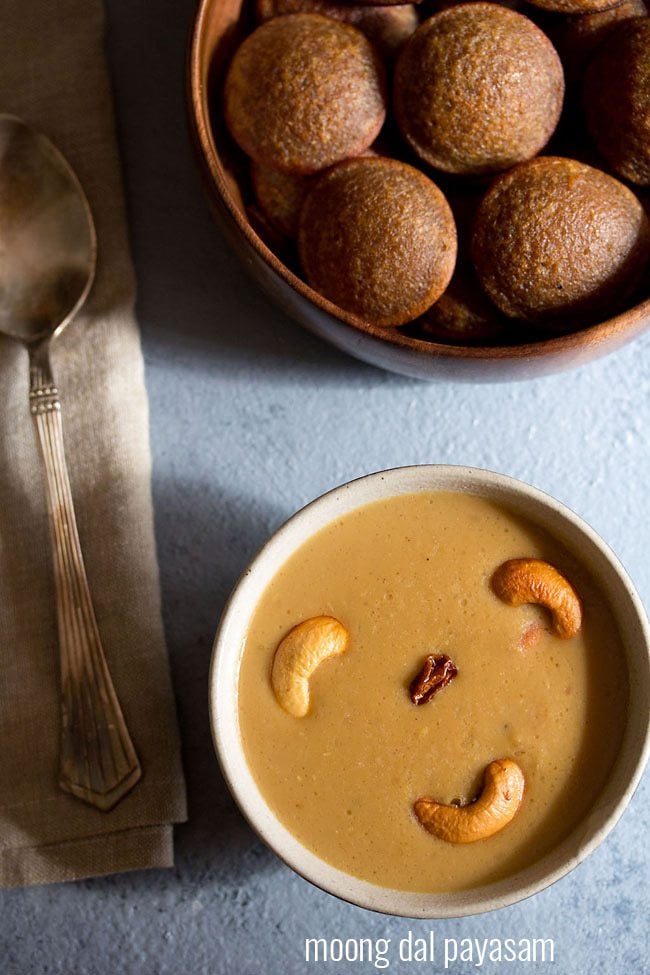
What is Payasam
Just like curries, India is synonymous with kheer, which is simply a sweet pudding. Payasam as it is known in South India has one of the main ingredients milk, in which another base ingredient is cooked along with a sweetener and some flavorings. This explains the meaning of the Sanskrit word ‘ksheer (milk),’ as the origin of the word kheer.
A traditional Indian recipe is this Kheer prepared by boiling rice grains in a mixture of milk, sweeteners and flavorings like cardamom, saffron, nuts, dry fruits, etc.
But South Indian cuisine is known to use a range of rice varieties & paruppu (dals) in their payasams. So, you have unique Paruppu Payasam like Pasi Paruppu Payasam made with moong dal, Kadalai Paruppu Payasam made with chana dal and so on.
Table of Contents
Other food cultures of the world also have rice payasam like dishes. For instance, ‘moghli or meghli’ of Lebanese cuisine, ‘rizogalo’ of Greek cuisine, ‘arroz con leche’ of Spanish/Mexican cuisine and the British porridge. In India, West Bengal has ‘payesh’ and the North Indian Phirni can be considered as a close relative of the kheer.
About Paruppu Payasam
Payasam is also that sweet dish which is usually made in most of the South Indian households during festive occasions. It is a common prasad served to devotees in temples as well. This Pasi Paruppu Payasam made with moong lentils is one of the tastiest versions of this dish.
At home, I make both kheer and Paruppu Payasam regularly. A delish dessert, this Pasi Paruppu Payasam is apt during festive celebrations. Also, a hit sweet ending on other special occasions and for guests. You can even make this payasam of pasi paruppu (moong dal) as an offering to deities or for your family and friends.
This Moong Dal Payasam recipe is a simple one, and anyone can make it by following it carefully. Make sure to use homemade coconut milk in this payasam, if you are making it as an offering to any deity or Lord Ganesha on Ganesh Chaturthi.
This Coconut Milk Recipe is going to show you the perfect way to prepare coconut milk at home. When preparing Pasi Paruppu Payasam for near and dear ones or guests, you can use either homemade or canned coconut milk.
How to make Paruppu Payasam
Cook Moong Lentils
1. Rinse ½ cup moong lentils (pasi paruppu) a couple of times. Take the moong lentils and 1 cup water in a small pan or bowl.
Place a small trivet in a 3 litre stovetop pressure cooker. Add 1.5 cups water in the pressure cooker.
Keep the small pan or bowl containing the lentils and water on the trivet. Pressure cook moong dal for 5 to 6 whistles or 9 to 10 minutes on medium heat.
You also have the option to cook the lentils directly in the cooker. In this case, you can add 1.5 cups water to the lentils and then pressure cook. The lentils can be cooked in a pan too.
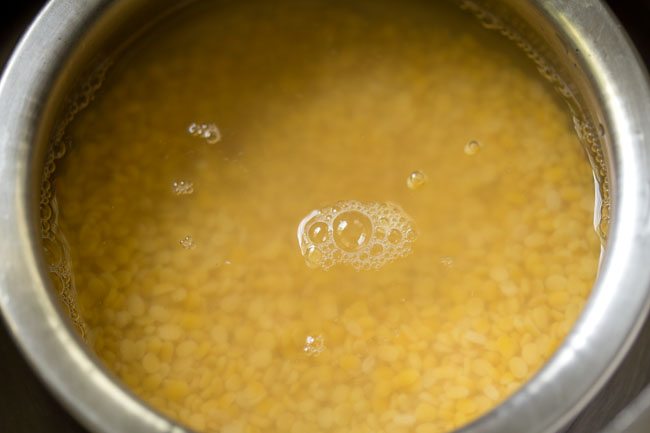
2. When the pressure settles down naturally, remove the lid and check the dal. It should be cooked well, and not be too pasty or lumpy.
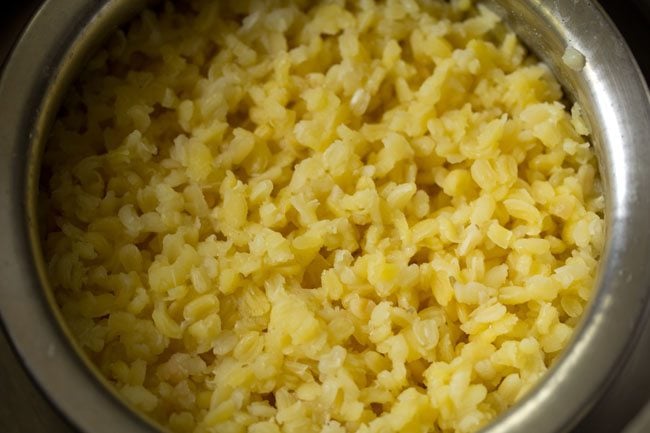
3. Pour the cooked moong dal and water in another pan or kadai.
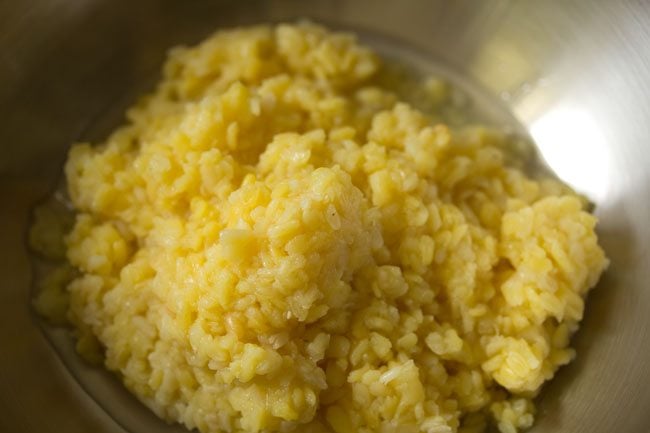
4. Mash the moong dal with a spoon.
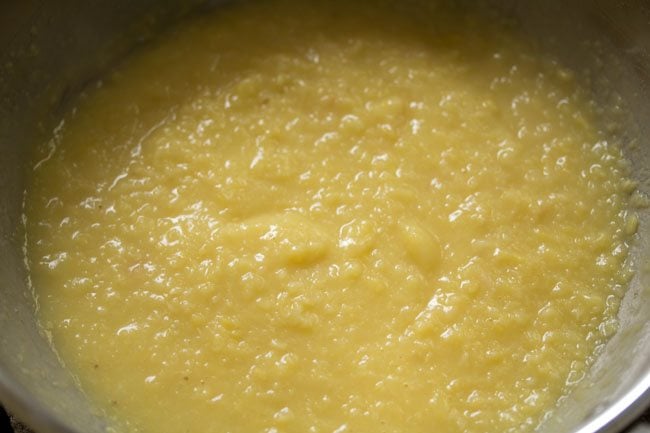
Make Pasi Paruppu Payasam
5. Add ½ cup thin coconut milk or water and mix well.
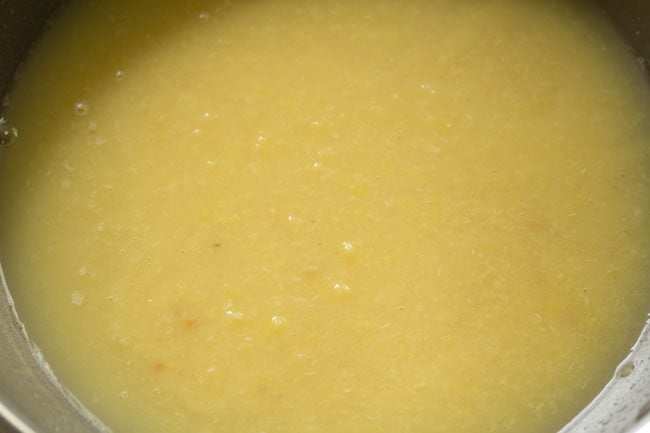
6. Add ¾ cup jaggery powder. For a less sweet taste, you can add ½ cup jaggery powder or grated jaggery.
If the jaggery has a lot of impurities, then heat it in ⅓ cup water on low heat and stir till it melts. Then, filter and use this syrup.
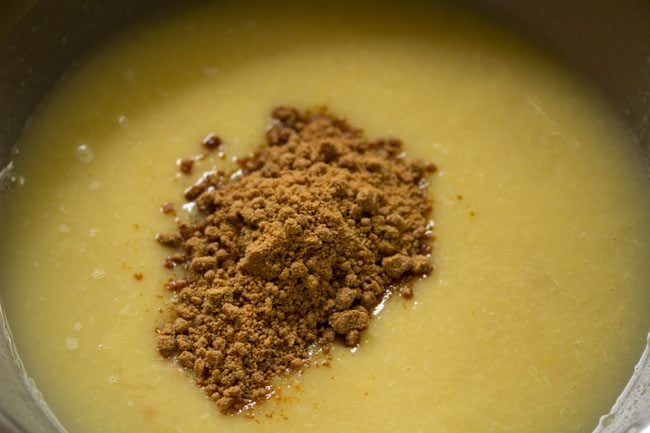
7. Keep the pan or kadai on stovetop and heat the mixture on low flame.
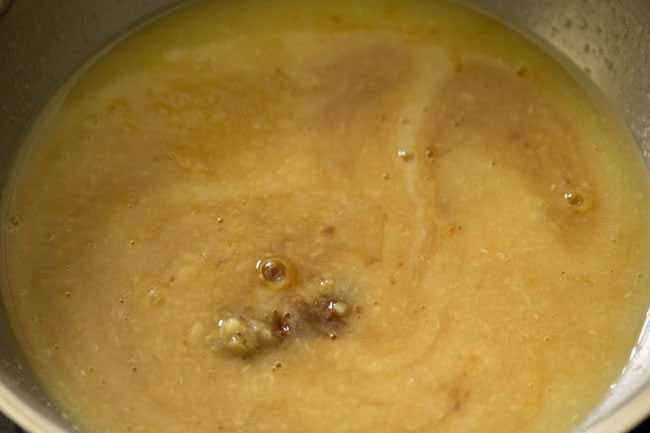
8. Keep on stirring so that the jaggery dissolves.
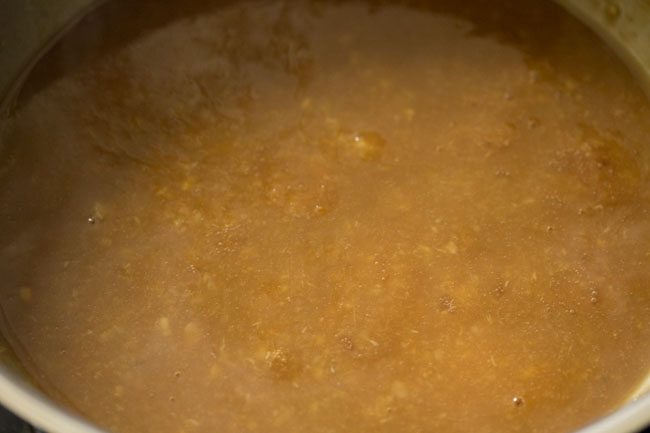
9. Once the jaggery has dissolves, add 1 cup thick coconut milk.
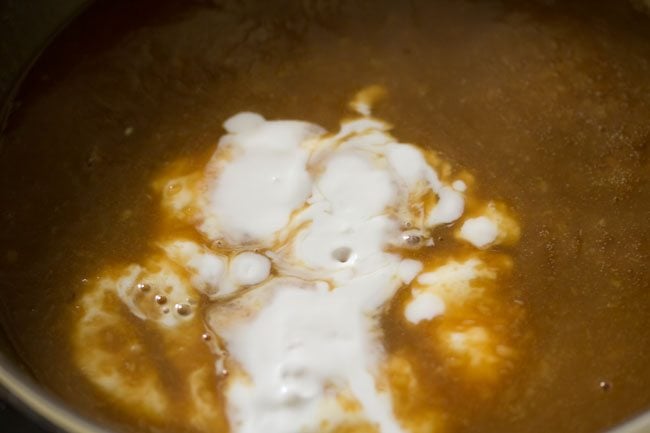
10. Mix very well and gently heat through for a minute or two. Turn off the heat and set aside. Do not over heat or boil as the coconut milk can curdle.
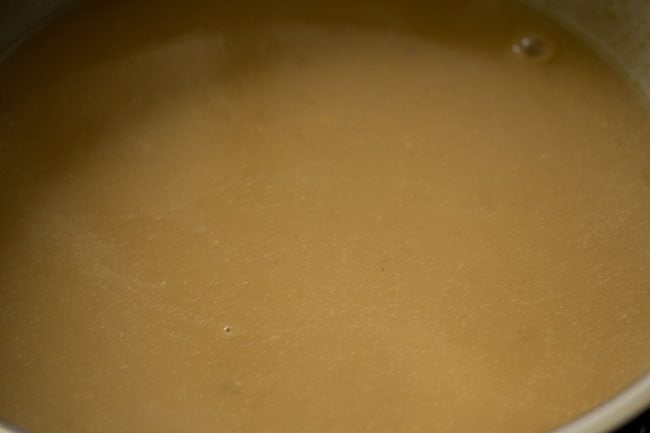
Fry Nuts & Raisins
11. In a small pan or tadka pan, heat 2 tablespoons coconut oil. Add 12 to 15 cashews. Instead of coconut oil, you can also use ghee.
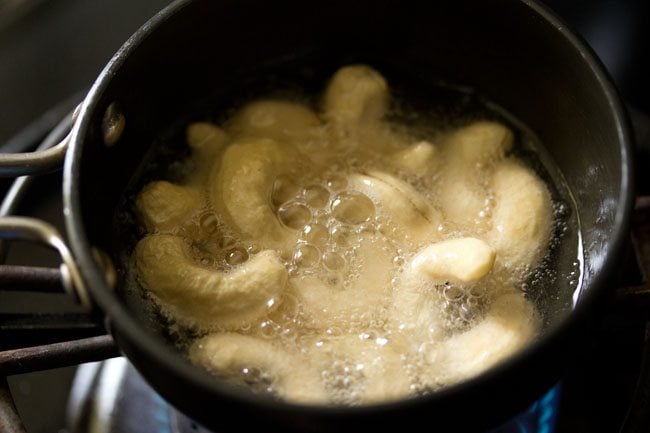
12. Fry till the cashews begin to turn golden.
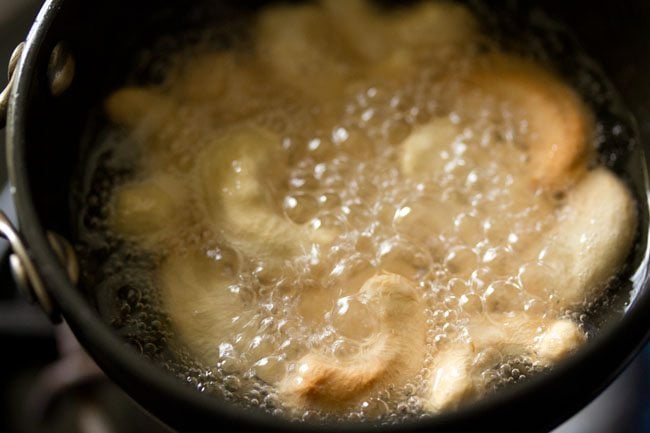
13. Once the cashews start becoming golden, add 1 tablespoon raisins and ½ teaspoon cardamom powder.
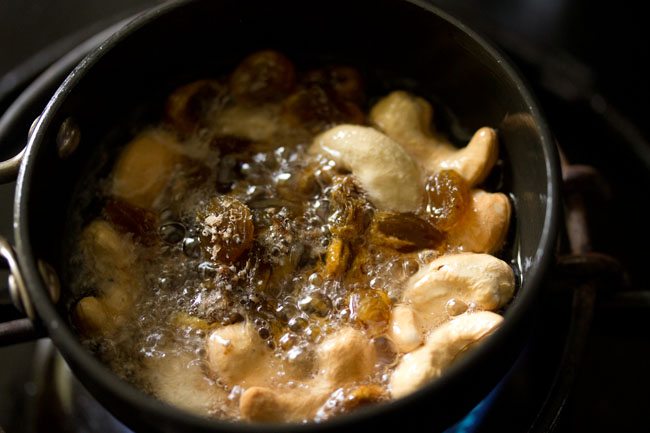
14. Fry the raisins till they swell and become plump.
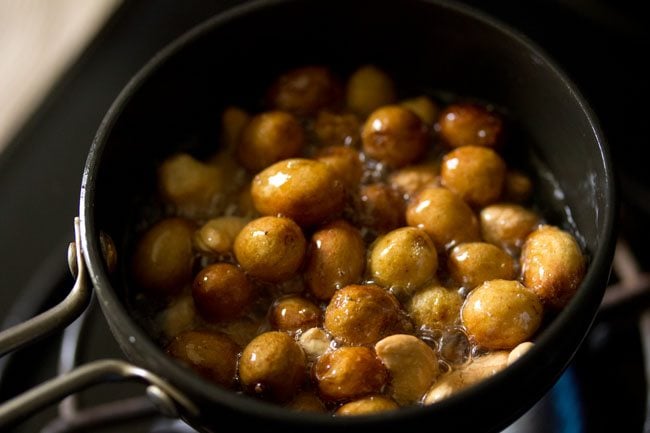
15. Now, pour the fried cashew-raisin mixture with the coconut oil in the payasam.
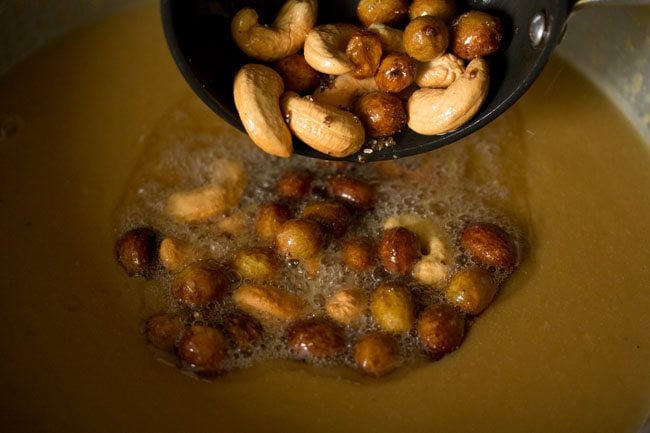
16. Mix very well.
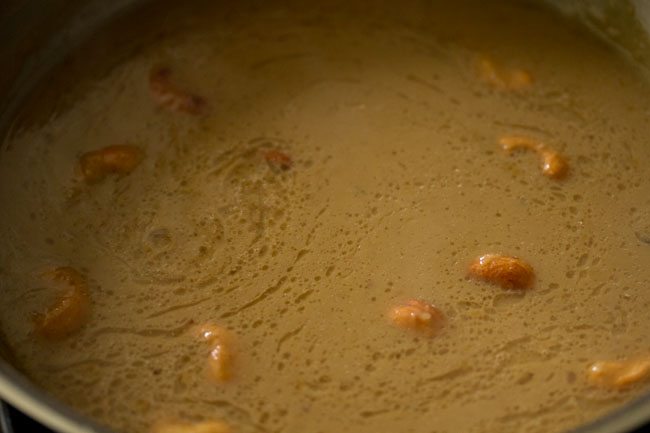
17. Serve Pasi Paruppu Payasam hot or warm. On cooling, the payasam will thicken. Refrigerate it as soon as it comes to room temperature.
This payasam keeps well for a couple of days when refrigerated. On cooling the payasam thickens.
Opt to serve it cold or lightly heat it until warm. If the consistency has become too thick, add a splash of water to thin it a bit.
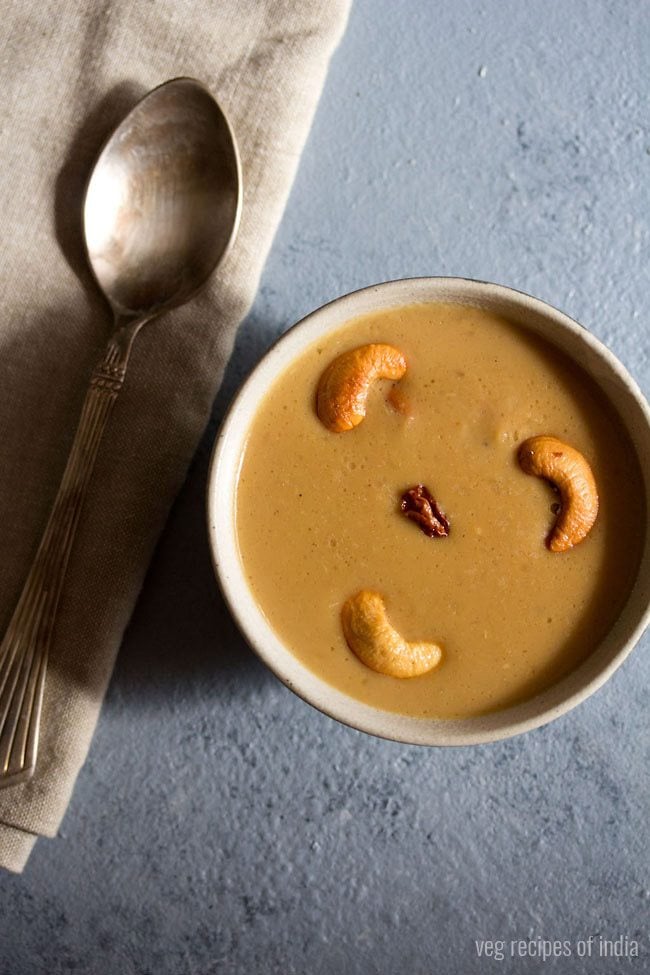
Paruppu in South India
As in any other regional cuisine of India, pulses with lentils (dals), beans, peas, etc. are a staple food for the people of South India too. Classified under the term paruppu, these may be used in the fresh form/sprouted or dried forms as whole, split with husk and split without husk.
A variety of paruppu is used in many recipes of southern India which range from a lentil-vegetable stew or Sambar, batters for popular snacks like idli, dosa, vada, etc. and dry veggie-dal dishes to rice based preparations and desserts like Paruppu Payasam etc.
Parupp usilli is a classic stir-fry from the cuisine of Tamil Nadu, made with banana flowers/French or cluster beans, toor dal, Bengal gram, red chilies, curry leaves, mustard seeds and asafoetida. The tradition is to serve it with steamed rice accompanied by a buttermilk or curd-based curry called Mor Kulambu.
Expert Tips
- No coconut milk? Don’t stress! Use preferred milk (dairy or plant based) to make this payasam.
- If using milk, you have to add it at room temperature. After adding it to the payasam, simmer just for 1 to 2 minutes and not more, or else the mixture may curdle or split.
- The moong lentils should be pressure cooked just well, not too pasty or lumpy.
- If the jaggery you are using has impurities, heat it in ⅓ cup water on low flame and stir till it melts. Then, filter and use this syrup.
- You may serve the Moong Dal Payasam hot or warm. Refrigerate only after it comes down to room temperature. Note that on cooling, the payasam thickens.
More Similar Recipes To Try!
South Indian Food Recipes
Sweets Recipes
Sweets Recipes
Please be sure to rate the recipe in the recipe card or leave a comment below if you have made it. For more vegetarian inspirations, Sign Up for my emails or follow me on Instagram, Youtube, Facebook, Pinterest or Twitter.
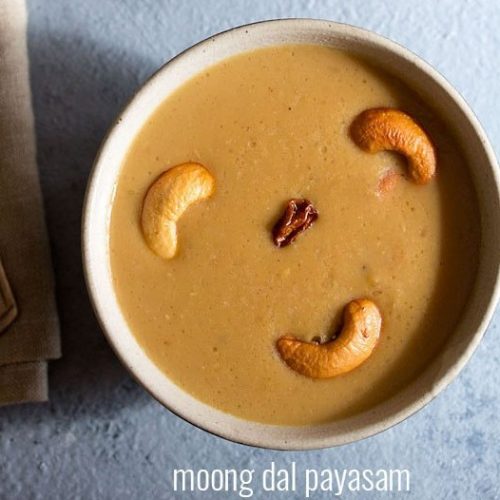
Paruppu Payasam | Moong Dal Payasam
Ingredients
For cooking moong lentils
- ½ cup moong dal – 100 grams, (pasi paruppu)
- 1 cup water – to be added in the pan containing moong dal
- 1.5 cups water – to be added in pressure cooker
Other ingredients
- ½ cup thin coconut milk or second or third extract or water, add as required
- ¾ cup jaggery powder or chopped or grated jaggery
- 1 cup thick coconut milk or first extract
- 2 tablespoons coconut oil
- ½ teaspoon green cardamom powder or seeds of 4 to 5 green cardamons, crushed in a mortar-pestle
- 12 to 15 cashews
- 1 tablespoons raisins
Instructions
Cooking moong dal
- Rinse the moong lentils a couple of times. Take the moong lentils and 1 cup water in a small pan.
- Pour 1.5 cups water in a stovetop pressure cooker. Keep a small trivet in the cooker. Place this small pan with the lentils and water on the trivet.
- Pressure cook moong dal for 5 to 6 whistles on medium heat or for 9 to 10 minutes. You can also opt to cook the lentils directly in the cooker. In this case, you can add 1.5 cups water to the lentils and then pressure cook.
- When the pressure drops naturally, remove the lid and check the lentils. The lentils should be cooked well and softened.
Making paruppu payasam
- Pour the entire contents of the small pan (cooked moong dal + water) in another pan or a kadai (wok).
- Mash the moong dal with a spoon.
- Add ½ cup thin coconut milk or water and mix well.
- Add the jaggery. For a less sweet taste, you can add ½ cup jaggery powder or grated jaggery.
- Keep the pan or kadai on stovetop and on a low flame heat this mixture.
- Keep on stirring so that the jaggery dissolves.
- Once all the jaggery dissolves, then add 1 cup of thick coconut milk.
- Mix very well and just gently heat through for a minute or two. Turn off the flame and set aside. Do not over heat or boil as the coconut milk can curdle.
Frying cashews and raisins
- In a small pan or tadka pan, heat 2 tablespoons coconut oil. Add 12 to 15 cashews.
- Fry until the cashews begin to get golden.
- Once the cashews start becoming golden, add 1 tablespoon raisins and and ½ teaspoon cardamom powder.
- Fry the raisins till they become plump and swell.
- Now pour the entire content of the tadka pan (coconut oil + cashews + raisins) in the payasam.
- Mix very well and serve pasi paruppu payasam hot or warm. Refrigerate the paruppu payasam as soon as it comes to room temperature.
- This payasam has to be refrigerated and it keeps well for a couple of days. On cooling it thickens. Opt to serve it cold or reheat until warm.
Notes
- Instead of coconut milk you can use milk also. When you add milk then it should be at room temperature and simmer for just 1-2 minutes only. Otherwise it can curdle.
- Feel free to make this payasam with your preferred plant based milk.
- Instead of jaggery, add sugar or any sweetener of your choice.
- If you prefer ghee, include it instead of coconut oil.
- The recipe can be scaled up to make for more servings.
Nutrition Info (Approximate Values)
This Paruppu Payasam from the archives was first published in August 2016. It has been updated and republished in February 2024.
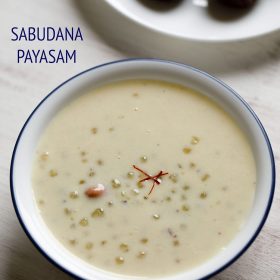
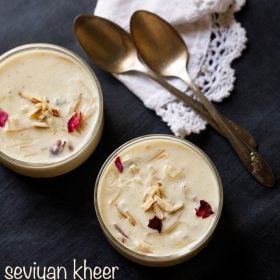
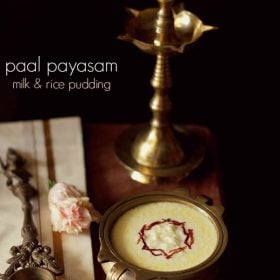
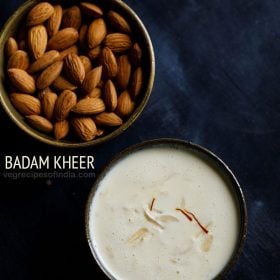
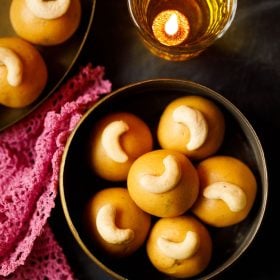
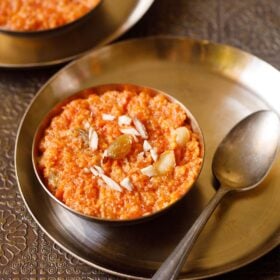
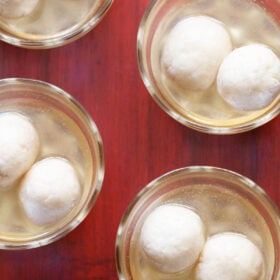
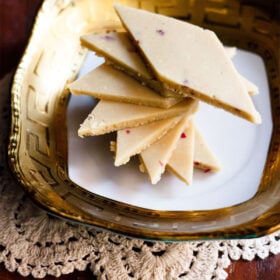








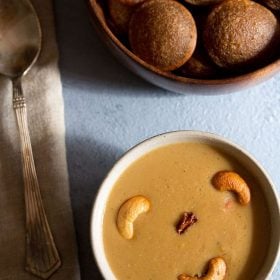
1. If I want to use coconut milk powder, how much should I use n at what stage?
2. Also if I don’t want to use a pressure cooker then what changes do I do for cooking the dal?
When using coconut milk powder, it has to be used carefully. So first make a thick coconut milk with the powder. Soak the moong dal for 30 minutes in water. Drain the water and add it in a pan or pot. Add 1.5 cups water and cook the dal. You can cover if you are using a slightly larger pot or pan or else the dal froths when being covered and cooked. If the cooked dal consistency looks thin, then cook further till the consistency thickens a bit. Add jaggery and mix well. Note you can always adjust the consistency before adding coconut milk by adding some water or cooking the dal more. When the jaggery has dissolved, then switch off flame. Keep the pan on the kitchen countertop and wait for 3 to 4 minutes. Then add coconut milk and mix well.
how many people will payasam made with 1/2 cup of moong dal feed
3 to 4 people. the recipe can be easily doubled or tripled.
Can I use normal milk ? How wil that affect the taste and can you please advise me when should we add jaggery in normal milk because the milk curdles sometimes.
you can add milk. taste will change with milk but will taste good. when jaggery and milk is cooked together, one should be at room temperature. if both are hot, then the milk will curdle. in this recipe, follow till step 8. when all jaggery is dissolved, then add milk which is at room temperature. mix and cook for about 2 to 3 minutes on a low flame. other way you can do is add milk first to the cooked moong dal. simmer till it comes to a boil. add jaggery. mix well and switch off the flame.
Can i use green moong dal for this recipe?
yes you can use green moong dal. but for green moong dal you may need to add more water while cooking.
when do we add the cardamom powder?
cardamom powder is added when raisins are added while frying cashews. i have forgotten to add this point in the post. thanks lizanne. i will update in the post.
Sounds delicious. Does this taste good warm or cold? Can I make it the day before I serve it?
It tastes good both warm or chilled. Personally I prefer the payasam to be hot or warm while serving. Yes you can make it a day before and refrigerate.
Nice. Tasty. Healthy.
thanks manjunath